|
|
| |
SPAIN
MADRID
Madrid is the capital city of Spain, located right in the centre of the Iberian Peninsula. It is also the largest Spanish city with more than 3 million inhabitants in the metropolitan area. It is the third largest city in the European Union, after London and Berlin. You will find in the city a rich mixture of cultures. Madrid is indeed a very active city with a bustling nightlife, busy business centres and lively streets either by day or night. The city has a wide offer for tourism, culture, business and for ludic activities with excellent facilities and services. Madrid's influences in politics, education, entertainment, environment, media, fashion, science, and the arts all contribute to its status as one of the world's major global cities. Due to its economic output, high standard of living, and market size, Madrid is considered the major financial centre of Southern Europe.
While Madrid possesses a modern infrastructure, it has preserved the look and feel of many of its historic neighbourhoods and streets. Its landmarks include the Royal Palace of Madrid; the Teatro Real (Royal theatre) with its restored 1850 Opera House; the Buen Retiro park, founded in 1631; the 19th-century National Library building (founded in 1712) containing some of Spain's historical archives; an archaeological museum; and the Golden Triangle of Art, located along the Paseo del Prado and comprising three art museums: Prado Museum, the Museo Nacional Centro de Arte Reina Sofía, a museum of modern art, and the Thyssen-Bornemisza Museum, housed in the renovated Villahermosa Palace.
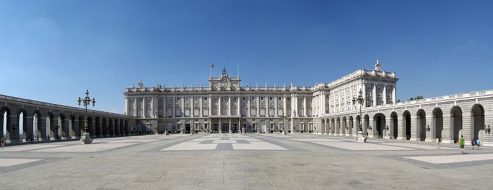 Royal Palace of Madrid
Royal Palace of Madrid
The Palacio Real de Madrid is the official residence of the King of Spain in the city of Madrid, but it is only used for state ceremonies. The palace is located on Bailén Street, in the Western part of downtown Madrid, East of the Manzanares River, and is accessible from the Ópera metro station. The palace is partially open to public, except when it is being used for official business. Interior of the palace is notable for its wealth of art, both as regards the use of all kinds of fine materials in its construction and the decoration of its rooms with artwork of all kinds, including paintings by artists such Caravaggio, Velázquez, Francisco de Goya and frescoes of Corrado Giaquinto, Giovanni Battista Tiepolo and Anton Raphael Mengs. Other collections of great historical and artistic importance that are preserved in the building are the Royal Armoury, Porcelain, Watches, Furniture and Silverware.
Teatro Real
The Teatro Real (literally Royal Theatre) is a major opera house located in Madrid, Spain. The opera house is located just in front of the Palacio Real. The theatre stages around seventeen opera titles (both own productions and co-productions with other major European opera houses) per year, as well as two or three major ballets and several recitals. The orchestra of the Teatro Real is the Orquesta Sinfónica de Madrid. The company staged the first modern revival of Vicente Martín y Soler's Il burbero di buon cuore in 2007.
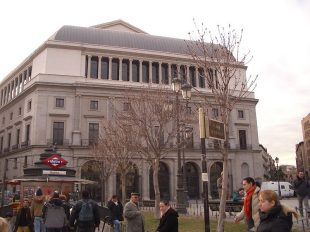
Royal Theater of Madrid
Photo: GramolerosBuen Retiro Park
The Jardines del Buen Retiro or Parque del Buen Retiro is the largest park of the city of Madrid, capital of Spain. The park belonged to the Spanish Monarchy until the late 19th century, when it became a public park. Buen Retiro Park is located at the edge of the city center, very close to the Puerta de Alcalá and not far from the Prado Museum. It is a magnificent park, filled with beautiful sculpture and monuments, galleries, a peaceful lake and host to a variety of events, it is one of Madrid's premier attractions.
 Monument to Alfonso XII in
Buen Retiro Park, MadridBiblioteca Nacional de España
The Biblioteca Nacional de España ('National Library of Spain') is a major public library, the largest in Spain. It is located in Madrid, on the Paseo de Recoletos. The library was founded by King Philip V in 1712 as the Palace Public Library. As the country's national library it is the centre responsible for identifying, preserving, conserving and disseminating information about Spain's documentary heritage and it aspires to be an essential point of reference for research into Spanish culture. The library's collection consists of more than 26,000,000 items including 15,000,000 books and other printed materials, 30,000 manuscripts, 143,000 newspapers and serials, 4,500,000 graphic materials, 510,000 music scores, 500,000 maps, 600,000 sound recording, 90,000 audiovisuals, 90,000 electronic documents and more than 500,000 microforms.
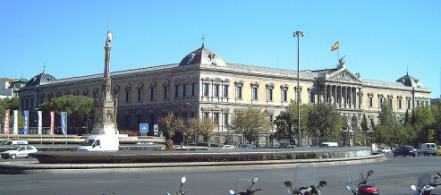 View of the façade of the National Library of Spain
Photo: Luis García
The Golden Triangle of Art is made up of three important art museums that are close to each other in the centre of Madrid, Spain. They form a general triangle shape upon a map. The three art museums are:
the Prado Museum, ("Museo del Prado" in Spanish), National Museum featuring pre-20th century art
the Thyssen-Bornemisza Museum, private museum, historical through contemporary art
the Museo Nacional Centro de Arte Reina Sofía, National Museum featuring 20th century modern art
National Archaeological Museum of Spain
The National Archaeological Museum of Spain is located beside the Plaza de Colón (Columbus Square), sharing its building with the National Library. It was founded in 1895 by Isabella II and its purpose was to be a depository for numismatic, archaeological, ethnographical and decorative art collections compiled by the Spanish monarchs. The current collection includes, among others, Pre-historic, Celtic, Iberian, Greek and Roman antiquities and medieval (Visigothic, Muslim and Christian) objects. Famour artefacts include a replica of the Altamira cave, Lady of Elx, Lady of Baza, Biche of Balazote and the Treasure of Guarrazar.
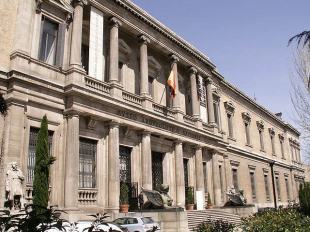 Façade of the National Archaeological Museum of Spain Photo: J.L. De Diego Paseo del Prado
The Paseo del Prado is one of the main boulevards in Madrid. It runs north-south between the Plaza de Cibeles and the Plaza del Emperador Carlos V, with the Plaza de Cánovas del Castillo lying approximately in the middle. This densely tree-lined, wide and centric avenue is a landmark for the city residents and the location of important cultural and tourist spots in the city.
Plaza Mayor
The Plaza Mayor was built during the Habsburg period and is a central plaza in the city of Madrid. It is located only a few blocks away from another famous plaza, the Puerta del Sol. It has a total of nine entranceways. The Casa de la Panadería, serving municipal and cultural functions, dominates the Plaza Mayor. The Plaza Mayor has been the scene of multitudinous events: markets, bullfights, soccer games, public executions, and, during the Spanish Inquisition, "autos de fe" against supposed heretics and the executions of those condemned to death. The Plaza Mayor also has a ring of old and traditional shops and cafes under its porticoes
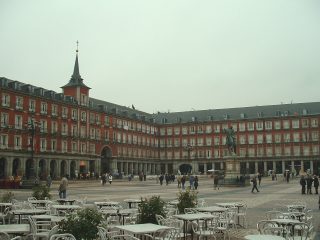 Plaza Mayor, Madrid
Photo EBGPlaza de Cibeles
The Plaza de Cibeles is a square with a neo-classical complex of marble sculptures with fountains that has become an iconic symbol for the city of Madrid. The most prominent of the buildings at the Plaza de Cibeles is the Palacio de Comunicaciones or Communications Palace. The cathedral-like landmark was built in 1909 by Antonio Palacios as the headquarters of the postal service. This impressive building was home to the City HallPostal and Telegraphic Museum until 2007 when the landmark building became Madrid's official city hall (Ayuntamiento de Madrid).
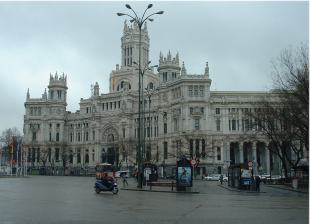 Plaza de Cibeles Photo EBG
The Museo del Prado is a museum and art gallery located in Madrid. It features one of the world's finest collections of European art, from the 12th century to the early 19th century, based on the former Spanish Royal Collection. Founded as a museum of paintings and sculpture, it also contains important collections of other types of works. El Prado is one of the most visited sites in the world, and it is considered to be among the greatest museums of art. The best known work on display at the museum is Las Meninas by Velázquez.
Museo Nacional Centro de Arte Reina Sofía
The Museo Nacional Centro de Arte Reina Sofía (MNCARS) is the official name of Spain's national museum of 20th century art. It is located in Madrid, near the Atocha train and metro stations. The museum is mainly dedicated to Spanish art. Highlights of the museum include excellent collections of Spain's two greatest 20th century masters, Pablo Picasso and Salvador Dalí. Certainly the most famous masterpiece in the museum is Picasso's painting Guernica. It also hosts a free-access library specializing in art, with a collection of over 100,000 books, over 3,500 sound recordings and almost 1,000 videos.
Puerta de Alcalá
The Puerta de Alcalá ("Alcalá Gate") is a Neo-classical monument in the Plaza de la Independencia ("Independence Square") in Madrid. It stands near the city center and several meters away from the main entrance to the Parque del Buen Retiro. The square is bisected by Alcalá street, although the street itself doesn't cross through the monument, and it is the origin of the Alfonso XII, Serrano and Olózaga streets.
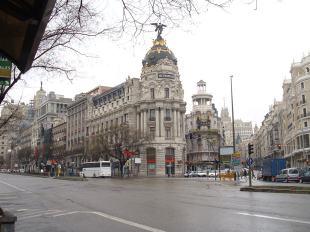 Alcalá Street and the Metropolis Building
Photo PKG
|
|
|
Festivals & Events
Seville Fair
The Feria de abril de Sevilla, literally Seville April Fair, is held
in the Andalusian capital of Seville, Spain. The fair generally begins
two weeks after the Semana Santa, or Easter Holy Week. The fair
officially begins at midnight on Monday, and runs six days, ending on
the following Sunday. Each day the fiesta begins with the parade of
carriages and riders, at midday, carrying Seville's leading citizens
which make their way to the bullring, La Real Maestranza, where the
bullfighters and breeders meet.
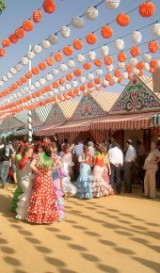 Casetas at Seville Fair
Photo: EdTarwinski
San Fermín
The festival of San Fermín is renowned for it's celebratory
tradition and is held in Pamplona anually on the 6th July. It is known
locally as Sanfermines and is held in honour of Saint Fermin. This
festival is important in terms of Spanish folklore and tradition. The
week long fiesta is most famous for it's encierro (running of the
bulls). It is belived that a million people flock to see this event
every year. The opening of the fiesta is marked by setting off the
pyrotechnic chupinazo. The rocket is launched at 12:00 noon on the 6th
of July from a city hall balcony with thousands of people celebrating
the act in the city hall square and other locations in Pamplona.
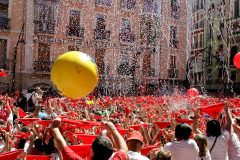 San Fermín Festival seen from
the Town Hall in Pamplona
Photo: Viajar24h
Fiestas del Pilar
Fiestas del Pilar is a large festival that takes place in Zaragoza,
Spain. This festival is religiously rooted in Spain and based on the
belief that Virgin Mary appeared to Saint James standing on a pillar.
The celebration lasts for seven days during which the city is bustling
with energy as over two million people visit the city for this fiesta.
Every day at 8 o'clock in the morning there is an event called
vaquillas, that is amateur bullfighting in the towns bullfighting ring,
or Plaza de toros. Everyone who is brave enough, can participate in this
event, in which many people get injured every year. The most important
celebration takes place on the 12th October, "The offering of flowers"
to the Virgin, who is removed from the Basilica and exhibited in a
platform placed on the square where the temple lies. The Offering of
Flowers is one of the more famous festive symbols of Spain.
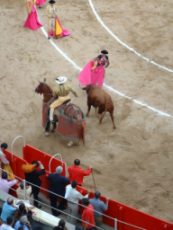 San Fermín Festival seen from
Bull running in Barcelona
Photo: BPG
Carnival
Carnival is a festive season which occurs immediately before Lent;
the main events are usually during February. Carnival typically involves
a public celebration or parade combining some elements of a circus,
mask and public street party. The Santa Cruz de Tenerifeand Las Palmas
de Gran Canaria is together with the Carnival of Cadiz, the most
important festival for Spanish tourism and Spain's largest carnival. In
Catalonia people dress up and organise parties for a week but
particularly on the weekend. Despite it being winter, parties are open
air, beginning with a cercavila to call everybody to come. Rues of
people dance along the streets. On Thursday Dijous Gras is celebrated,
also called 'the omelette day' and omelettes are eaten. Parties end by
burning Mr. Carnestoltes and with enterrament de la sardina (sardine's
funeral). Carnaval de Solsona takes place in Solsona, Lleida in central
Catalonia. It is one of the longest carnivals in Catalonia; free events
in the streets, and concerts every night, run for more than a week.
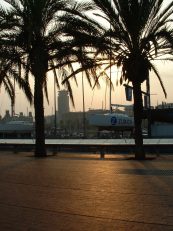 Barcelona harbour
Photo: BPG
Festival Internacional de Benicàssim
The Festival Internacional de Benicàssim is an annual music festival
sponsored by a well known beer label which takes place in the village of
Benicàssim, province of Castelló, Valencian Community in Spain. It
focuses mainly on pop, rock and electronica artists, as well as having
other elements besides music like short films, theatre, fashion and art.
Since the first festival in 1995, some of the most notable artists who
have played the festival include Paul Weller, Depeche Mode, Beck,
Radiohead, Kraftwerk, The Stone Roses, Brian Wilson, Blur, Lou Reed,
Oasis, The Chemical Brothers, Franz Ferdinand, The Killers, Morrissey,
Sigur Rós, Ride and The Strokes. As of 28 January, the line up for the
2011 Festival is as follows: Arcade Fire, Arctic Monkeys, Mumford &
Sons, Portishead, The Strokes, Beirut, Catpeople, Elbow, Friendly Fires,
Julieta Venegas, Lori Meyers, Primal Scream (present Screamadelica),
The Streets, Tinie Tempah, The Coronas, Grupo Salvaje, The Marzipan Man
Smile, Veronica Falls, Paolo Nutini, Pendulum, Mahmiri Acar. 'FIB' is
held in the seaside resort of Benicassim (Castellón province) on Costa
del Azahar, Valencia, Spain, 92.2 km away from Valencia Airport.
Festival goers who have purchased multi-day passes can camp for up to 9
days starting Monday before the festival starts and ending Tuesday after
the festival has ended. For more information please contact info@fiberfib.com
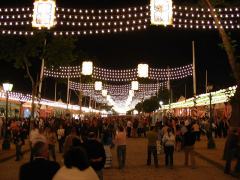
Festimad
Festimad is an alternative rock festival and cultural event held yearly
in Madrid, Spain since 1994, usually in the last week of May. Festimad
includes several parallel cultural festivals such as Performa, Graffiti,
Universimad o Cinemad, although its central event continues to be the
music festival, standing alongside the Festival Internacional de
Benicàssim as Spain's main rock concert. For more information please
contact festimad@festimad.es
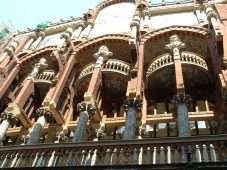 Photo: BPG
Bilbao Live Festival
The Bilbao Live Festival is a rock and pop music festival that takes
place in the summer in Bilbao, Spain since 2006. It is supported by BBK
the savings bank. Some 51,000 people attended the first edition of
Bilbao Live Festival in 2006, an event that reunited during three days
more than 40 national and international bands of rock and carps of
electronic music. Bilbao had thus burst in with force into the circuit
of great musical festivals of the summer time. The 2011 lineup includes
Coldplay, Blondie, Beady Eye, Crystal Castles, Russian Red, Ken Zazpi,
Amy Winehouse, Kasabian, Kaiser Chiefs, The Black Crowes, The Chemical
Brothers, Jack Johnson, 30 Seconds to Mars, M-Clan. For more information
please contact festivals@nme.com
|